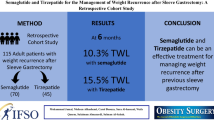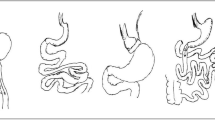Abstract
Background
One-Anastomosis Gastric Bypass (OAGB) has exponentially increased in the last decade, as it is associated with very low complications, mortality, readmissions and reoperations rates, and shows excellent short- and long-term benefits of weight loss and resolution of comorbidities. The aim of this study was to compare the effect of SG, RYGB, and OAGB, on short- and long-term weight loss and comorbidities resolution.
Methods
A prospective randomized clinical study of all morbidly obese patients undergoing SG, RYGB, and OAGB, as primary bariatric procedures, was performed. Patients were randomly assigned into 3 groups: those patients undergoing SG, those ones undergoing RYGB and those ones undergoing OAGB. BMI, excess BMI loss (EBMIL) and remission of type 2 diabetes (T2DM), hypertension (HT), and dyslipidemia (DL) were assessed.
Results
600 patients were included in the study, 200 in each group. Follow-up rate at 5 years postoperatively was 91% in SG group, 92% in RYGB, and 90% in OAGB. OAGB achieves significantly greater EBMIL than RYGB and SG at 1, 2, and 5 years (p < 0.001, respectively). At 5 years, OAGB achieves significantly greater remission of T2DM (p = 0.027), HT (p = 0.006), and DL (p < 0.001) than RYGB and SG. RYGB did not show significant superiority than SG in short- and long-term remission of T2DM and HT, but achieves greater remission of DL (p < 0.001).
Conclusion
OAGB achieves superior mid- and long-term weight loss than RYGB and SG. There are no significant differences in weight loss between SG and RYGB at 1, 2, and 5 years. OAGB achieves better short- and long-term resolution rates of DM, HT, and DL than SG and RYGB. RYGB and SG obtain similar T2DM and HT remissions, but RYGB reaches significantly greater rates of DL remission. ClinicalTrials.gov Identifier: NCT03467646.





Similar content being viewed by others
Change history
16 January 2021
A Correction to this paper has been published: https://doi.org/10.1007/s00464-021-08298-0
References
Health topics. Obesity. World Health Organization (WHO June 2016). http://www.who.it
Ogden CL, Carroll MD, Lawman HG et al (2016) Trends in obesity prevalence among children and adolescents in the United States, 1988–1994 through 2013–2014. JAMA 315:2292–2299
Melissas J, Stavroulakis K, Tzikoulis V et al (2017) Sleeve gastrectomy vs Roux-en-Y gastric bypass. Data from IFSO-European chapter center of excellence program. Obes Surg 27:847–855
Carbajo MA, Luque de Leon E, Jimenez JM et al (2017) Laparoscopic one-anastomosis gastric bypass: technique, results and long-term follow-up in 1200 patients. Obes Surg 27:1153–1167
Himpens J, Dobbeleir J, Peeters G (2010) Long-term results of laparoscopic sleeve gastrectomy for obesity. Ann Surg 252:319–324
Padwal R, Klarenbach S, Wiebe N et al (2011) Bariatric surgery: a systematic review and network meta-analysis of randomized trials. Obes Rev 12:602–621
Angrisani L, Santonicola A, Iovino P et al (2015) Bariatric surgery worldwide 2013. Obes Surg 25:1822–1832
Alvarez V, Carrasco F, Cuevas A et al (2016) Mechanisms of long-term weight regain in patients undergoing sleeve gastrectomy. Nutrition 32:303–308
IFSO European Database control. http://www.eac-bs.com
Ruiz-Tovar J, Martinez R, Bonete JM et al (2016) Long-term weight and metabolic effects of laparoscopic sleeve gastrectomy calibrated with a 50-Fr Bougie. Obes Surg 26:32–37
El-Kadre L, Tinoco AC, Tinoco RC et al (2013) Overcoming the learning curve of laparoscopic Roux-en-Y gastric bypass: a 12-year experience. Surg Obes Relat Dis 9:867–872
Higa K, Ho T, Tercero F et al (2011) Laparoscopic Roux-en-Y gastric bypass: 10-year follow-up. Surg Obes Relat Dis 7:516–525
Disse E, Pasquer A, Espalieu P et al (2014) Greater weight loss with the omega loop bypass compared to Roux-en-Y gastric bypass: a comparative study. Obes Surg 24:841–846
Jammu GS, Sharma R (2016) A 7-year clinical audit of 1107 cases comparing sleeve gastrectomy, Roux-en-Y gastric bypass, and mini gastric bypass, to determine an effective and safe bariatric and metabolic procedure. Obes Surg 26:926–932
Lee WJ, Ser KH, Lee YC et al (2012) Laparoscopic Roux-en-Y vs. mini gastric bypass for the treatment of morbid obesity: a 10-year experience. Obes Surg 22:1827–1834
Lee WJ, Yu PJ, Wang W et al (2005) Laparoscopic Roux-en-Y versus mini-gastric bypass for the treatment of morbid obesity: a prospective randomized controlled clinical trial. Ann Surg 242:20–28
Buchwald H, Avidor Y, Braunwald E et al (2004) Bariatric surgery: a systematic review and meta-analysis. JAMA 292:1724–1737
Shoar S, Saber AA (2017) Long-term and midterm outcomes of laparoscopic sleeve gastrectomy versus Roux-en-Y gastric bypass: a systematic review and meta-analysis of comparative studies. Surg Obes Relat Dis 13:170–180
Salminen P, Helmiö M, Ovaska J et al (2018) Effect of laparoscopic sleeve gastrectomy vs laparoscopic Roux-en-Y gastric bypass on weight loss at 5 years among patients with morbid obesity: the SLEEVEPASS randomized clinical trial. JAMA 319:241–254
Karra E, Yousseif A, Batterham RL (2010) Mechanisms facilitating weight loss and resolution of type 2 diabetes following bariatric surgery. Trends Endocrin Met 21:337–344
Gaziano TA, Abrahams-Gessel S, Alam S et al (2016) Comparison of nonblood-based and blood-based total CV risk scores in global populations. Glob Heart 11:37–46
Mechanick JI, Youdim A, Jones DB et al (2013) Cliniacl practice guidelines for the perioperative nutritional, metabolic and nonsurgical support of the bariatric surgery patient – 2013 update: cosponsored by American Association of clinical endocrinologists, The Obesity Society, and American Society of Metabolic & Bariatric Surgery. Surg Obes Relat Dis 9:159–191
Author information
Authors and Affiliations
Corresponding author
Ethics declarations
Disclosures
Jaime Ruiz-Tovar, Miguel Angel Carbajo, Jose Maria Jimenez, Maria Jose Castro, Gilberto Gonzalez, Javier Ortiz-de-Solorzano, Lorea Zubiaga have no conflicts of interest or financial ties to disclose.
About this article
Cite this article
Ruiz-Tovar, J., Carbajo, M.A., Jimenez, J.M. et al. RETRACTED ARTICLE: Long-term follow-up after sleeve gastrectomy versus Roux-en-Y gastric bypass versus one-anastomosis gastric bypass: a prospective randomized comparative study of weight loss and remission of comorbidities. Surg Endosc 33, 401–410 (2019). https://doi.org/10.1007/s00464-018-6307-9
Received:
Accepted:
Published:
Issue Date:
DOI: https://doi.org/10.1007/s00464-018-6307-9




